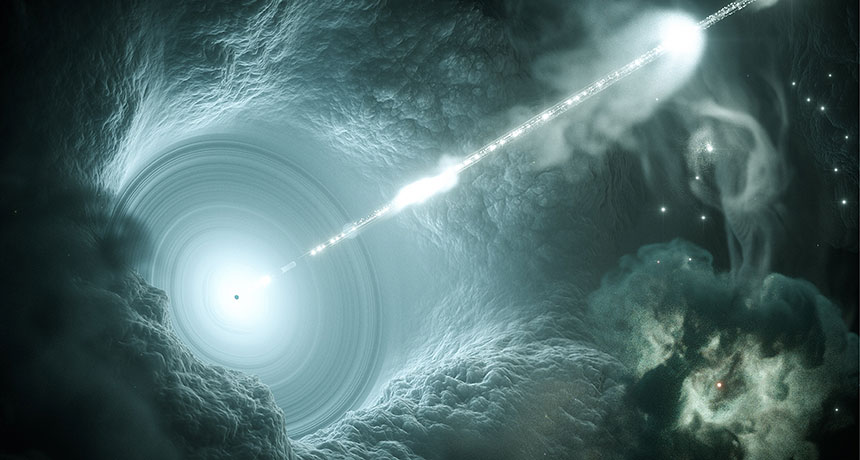A high-energy neutrino has been traced to its galactic birthplace

A zippy little particle has been traced back to its cosmic stomping grounds, a flaring galaxy 4 billion light-years away, for the first time solving a cosmic whodunit.
Scientists have long puzzled over the sources of high-energy particles from space, which batter the Earth at energies that can outstrip the world’s most advanced particle accelerators. Now, physicists have identified the source of an energetic, lightweight particle called a neutrino. The intergalactic voyager came from a type of bright galaxy called a blazar located in the direction of the constellation Orion, scientists report online July 12 in Science.
“This is super exciting news,” says astrophysicist Angela Olinto of the University of Chicago, who was not involved with the new result. “It’s marking the beginning of what we call neutrino astronomy,” which uses the nearly massless particles to reveal secrets of cosmic oddities like blazars. While there may be additional cosmic sources for high-energy neutrinos, the detection indicates that at least some come from blazars.
The result also suggests that blazars emit other energetic particles known as cosmic rays, which are produced in tandem with neutrinos. The origins of high-energy cosmic rays are poorly understood and until now, “nobody has ever been able to pinpoint a source that produces them,” says astrophysicist Francis Halzen of the University of Wisconsin–Madison, a leader of IceCube, the Antarctic neutrino observatory that detected the particle.
Thanks to this discovery, “we will better understand nature of the universe’s immense cosmic accelerators,” France Córdova said in a July 12 news conference in Alexandria, Va. Scientists can’t produce such high-energy particles on Earth, “so we have to turn to the heavens to deepen our understanding of the highest-energy processes,” said Córdova, the director of the National Science Foundation, which funded IceCube.
IceCube, which was constructed within a cubic kilometer of ice sheet, uses thousands of embedded sensors to measure light produced when neutrinos slam into the ice. On September 22, 2017, IceCube detected a neutrino with an energy of nearly 300 trillion electron volts. (For comparison, protons in the Large Hadron Collider in Geneva reach energies of 6.5 trillion electron volts.)
By tracing the neutrino’s track backward, scientists zeroed in on a region of sky in the direction of the constellation Orion. Astronomers leapt into action, and telescopes around the world scoured the spot for light that could reveal the particle’s source. A flare of gamma rays, a type of high-energy light, was detected by the Fermi Gamma-ray Space Telescope coming from a blazar called TXS 0506+056, a brilliant galaxy powered by an enormous black hole that launches a jet of energetic particles in the direction of Earth. A variety of telescopes observed the blazar’s flare in other types of light, including X-rays and radio waves.
Coming on the heels of the detection of gravitational waves and light from colliding neutron stars (SN: 11/11/17, p. 6) observed in August 2017, Fermi researcher Regina Caputo thought, “This is crazy, the sky is erupting,” she says. “I almost couldn’t believe it; the universe is revealing itself in ways we have never imagined before,” says Caputo, of NASA’s Goddard Space Flight Center in Greenbelt, Md.
The detection of high-energy neutrinos with a well-defined incoming direction is rare — IceCube sent astronomers only 10 reports of such detections in the year and a half before this neutrino was found. This was the first time researchers were lucky enough to also spot the source’s light.
“This is really what IceCube was built for, to try to see high-energy neutrinos from these exotic sources,” says neutrino physicist Kate Scholberg of Duke University, who was not involved with the research.
Previously, scientists have identified the birthplaces of neutrinos of much lower energies: an exploding star (SN: 2/18/17, p. 24) and the sun. But high-energy neutrinos have been more elusive. While there have been previous hints of high-energy neutrinos associated with blazar flare-ups (SN Online: 4/7/16), the new detection makes the first solid connection between blazars and high-energy neutrinos.
After unmasking the neutrino’s source, the IceCube researchers went back to their data and looked for additional neutrinos that could have come from the blazar. “There was something interesting happening there,” says IceCube researcher Naoko Kurahashi Neilson of Drexel University in Philadelphia. Over seven months starting in September 2014, IceCube saw a neutrino flare, an excess of high-energy neutrinos from that vicinity, the researchers report in a second paper published in the July 13 Science.
Blazars are still poorly understood, including what kinds of particles they blast out. Because high-energy neutrinos can be produced only in combination with protons, the detection reveals that blazars are also a source of cosmic rays, which consist of protons and atomic nuclei.
Cosmic rays have been detected on Earth at ultrahigh energies, and it’s been a mystery what kind of cosmic engine could rev particles up to those extremes. “This may be a clue to their origin,” says astrophysicist Floyd Stecker of NASA Goddard. But it’s still not clear whether blazars can accelerate protons to the very highest energies observed, he says.
The highest energy cosmic rays are known to come from outside the Milky Way (SN: 10/14/17, p. 7). But in general, cosmic rays leave few clues of their birthplaces: As they travel through space, their trajectories get twisted by magnetic fields, and therefore don’t reliably point back to their sources.
Neutrinos, on the other hand, are electrically neutral, which means they are unaffected by magnetic fields, traveling in a straight line from their origins to Earth. Since high-energy cosmic rays and neutrinos are produced together, the particles can help scientists understand cosmic rays as well, Olinto says. “What neutrinos gave us is a way through the fog.”